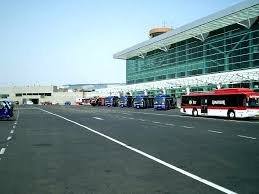An intense pre-monsoon thunderstorm early Saturday morning led to visible damage at Delhi’s Indira Gandhi International Airport. High-speed winds and heavy rainfall tore a portion of the canopy at the arrival section of Terminal 1, sparking concerns about passenger safety and infrastructure preparedness.
What Happened at Terminal 1?
According to officials, the incident occurred around 2 AM on May 25 when over 80 mm of rain and strong winds battered parts of Delhi-NCR. The force of the storm tore a section of the fabric canopy that covers the arrival forecourt of Terminal 1.
Several videos circulated on social media showing water gushing through the torn canopy, with parts of the fabric visibly sagging and flapping in the wind. No injuries were reported, and authorities quickly cordoned off the affected area.
Statement from Airport Authorities
In a public statement, the Delhi International Airport Ltd (DIAL) clarified:
“A portion of the tensile fabric at the forecourt of T1 arrival tore due to natural design behavior. The fabric is engineered to give way to reduce pressure from water accumulation. There is no structural compromise, and passenger safety remains intact.”
They added that the incident did not disrupt terminal operations significantly, though flight movement was temporarily impacted by weather-related visibility concerns.
Flight Operations Affected
Between midnight and 4 AM, about 49 flights were diverted — 32 domestic and 17 international — due to heavy rain and operational constraints. All operations resumed gradually by morning, and the damaged section was inspected and cleared for continued use by ground and safety teams.
Expert Analysis
A senior civil engineer familiar with airport infrastructure told The Indian Express:
“Tensile fabric is widely used in modern airport architecture due to its flexibility and light weight, but regular inspections are critical — especially before monsoon season. Even designed weaknesses should be reinforced for increasingly unpredictable weather events.”
Past Incidents Raise Infrastructure Questions
This event follows a similar incident last year when part of the canopy at the same terminal collapsed, resulting in injuries and major disruption. While DIAL claims no structural issues exist, the recurrence of such damage during storms raises larger questions about the resilience of public infrastructure under climate pressure.
Aviation analyst Mark D’Souza commented:
“Delhi Airport is a global hub. Passengers expect reliability. While this incident was minor, repeated weather-related damage could harm the airport’s image and customer trust.”
What Passengers Should Know
- Terminal 1 is fully operational.
- Passengers are advised to check flight status in advance, especially during severe weather periods.
- The Delhi Airport app and Twitter handle (@DelhiAirport) provide real-time updates.
- DIAL teams remain on-site to monitor safety and assist travelers.
Key Takeaways
- A portion of Terminal 1’s canopy tore during a thunderstorm on May 25.
- No injuries or major disruptions reported.
- 49 flights were diverted due to weather conditions.
- DIAL clarified that the tensile fabric tore as part of a designed safety mechanism.
- Passenger operations and structural integrity remain unaffected.
FAQs
Was Terminal 1 shut down after the incident?
No. The terminal remained operational. Only the immediate area beneath the damaged canopy was temporarily blocked off for safety.
Are there structural risks to the building?
According to DIAL, the tensile canopy is designed to tear under extreme pressure to prevent worse damage. An inspection confirmed no risk to the terminal structure.
What precautions are being taken for the monsoon season?
While no specific announcements have been made yet, DIAL is expected to review infrastructure resilience plans following this and past weather-related events.
Are similar designs used in other terminals?
Tensile architecture is common in modern airport designs, especially for outdoor or transitional spaces. Terminal 2 and 3 use different roofing systems.

